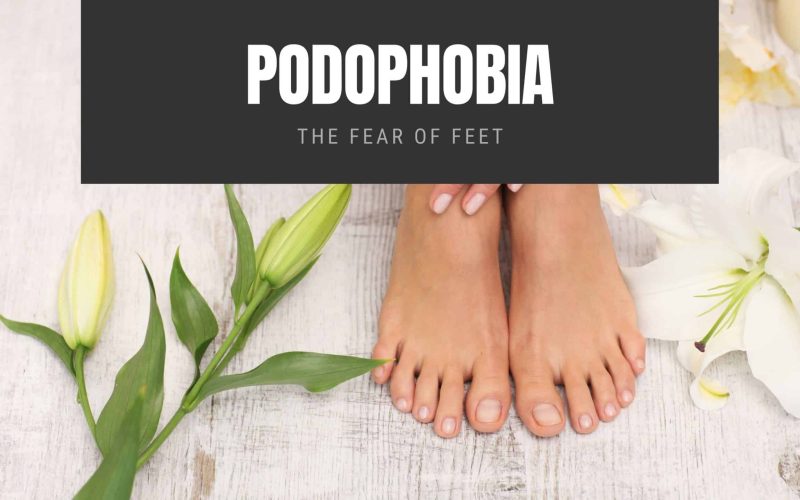Podophobia is the morbid and extreme fear of feet. Although this phobia may seem bizarre, it is quite common, and it affects several people globally.
Podophobia has a Greek origin from the combination of the Greek words “podos” and “phobos,” which mean “feet” and “fear or aversion,” respectively.
Sufferers of this condition are called Podophobics. Podophobics, at the sight or perception of feet or anything relating to feet, are likely to get upset or frightened.
Podophobia is not the same experience for everybody. At the same time, some do not appreciate it when another is touching or looking at their feet, some are triggered by the mere thought, talk, literature, and sight of anything relating to feet, and some are scared of their feet.
Extreme podophobia can be detrimental to the well-being and health of the podophobics because they would not like removing their shoes and socks even while sleeping; they would prefer to have them on at all time. This can cause them to develop allergies, fungal infections, and other health conditions.
Moreover, this condition can be overwhelming to the sufferer because almost everybody has feet, and developing a fear of feet means that you are at higher risk of getting triggered at all times since feet are practically everywhere.
Causes Podophobia
According to experts, the exact cause of phobias is unknown. However, contributing factors can cause an individual to develop phobias.
In this case, there are contributing factors that are believed to contribute to the development of podophobia.
They are;
- Negative past experiences
- Environment and upbringing
- Genetics and personality
Negative Past Experiences
These could be awful experiences relating to feet that the individual found traumatizing.
And we all know that unpleasant experiences are difficult to forget, and some people may develop Post Traumatic Stress Disorders (PTSD) because of them; therefore, an encounter with anything that can make the individual remember those past experiences can have the person triggered and cause the sufferer panic attacks or some symptoms.
For instance, a child who was brutally abused with kicks, forced to lick feet, or any other sad experiences relating to feet by an elder, parents, siblings, or bullies can have the child develop this mental condition.
Environment and Upbringing
A homophobic can get irritated or severely frightened at the thought, sight, or perception of anything relating to bare feet when he or she has been raised by or with a family member suffering from this condition.
The environment also has a crucial influence on an individual’s life; when a child is being raised in an environment with many people familiar to the child, suffering from this condition, or growing up in an environment with a wrong perception of feet.
Genetics and Personality
This is the internal factor that is majorly responsible for who we are. Experts believe that podophobia can be inherited from an ancestor or parent with this condition.
Moreover, people with a personality that causes them to be frequently anxious about things and situations and people with a kind of adrenal deficiency are at high risk of getting Podophobia.
The abovementioned factors are not all; some experts believe this condition may develop without any precise reason.
Again, painful experiences on foot, such as foot injuries and foot diseases including hammertoe, bunions, and so on, can make a person obsessively protective over his or her feet by always wearing socks or shoes even when sleeping; thus, the acquisition of fear of pain and feet.
Symptoms of Podophobia
Like other phobias, Podophobia can also be extreme and persistent. Podophobia comes with accompanying symptoms, which manifest physically and psychologically even when the individual realizes that this fear is irrational and uncalled for, especially with the fact that the feet are not dangerous.
However, the sufferer is unable to control these symptoms, especially in severe cases:
- Shortness of breath
- heart palpitations
- Extreme fear or anxiety
- Excess sweating
- Trembling
- Gastrointestinal upset
- Nausea
- Dizziness
- Feeling of faint
- Always covering one’s feet or asking other people to cover theirs
- Outright Refusal to discuss feet or anything relating to feet
In a few cases, podophobics may have podophobia so severe that they dread dying or death
People with severe cases of podophobia may start finding it difficult to socialize with people, make friends, sustain friendships and relationships, carry out their everyday tasks, and live their lives normally.
Treatment of Podophobia
Like every phobia, some treatments are efficient and available. The treatment of podophobia is essential to stop the condition from interfering with the individual’s usual way of living his or her life and give the person total recovery.
The treatments available are:
- Psychotherapy
- Medications
Psychotherapy
This is the use of psychological techniques by mental health workers to help their clients obtain desired results. This is used to treat phobias, specifically podophobia, successfully.
Cognitive-Behavioral Therapy
Cognitive-behavioral therapy is commonly used in this technique. This form of treatment is aimed at helping you identify negative thoughts, beliefs, and behavioral patterns and then help you turn them into positive ones.
Using this approach, your negative perception of your feet is altered into a positive view, making you feel good about them and not anxious about anything related to feet, including bare feet.
Desensitization
This form of therapy involves the gradual exposure of the patient to their source of fear in a professionally controlled environment.
This works by desensitizing the sufferer at each exposure, thereby reducing anxiety response.
This is an effective form of treatment; however, there are risks of making the condition worse when applied carelessly; therefore, this should be done by an expert.
First, you are prepared to have a little discussion about feet before gradually being exposed to feet-looking images and objects, before they have you see a real barefoot and even give you the chance to touch them.
This is set up in stages, and when you pass a stage of exposure without any symptoms, you are allowed to progress to the next level of exposure. This operation aims to make you less sensitive to feet and anything related to them.
Hypnotherapy
This is a form of therapy where your therapist opens your subconscious mind to reprogram those negative thoughts, beliefs, and behavioral patterns into positive ones, convincing you that there is no need to be afraid.
Your therapist convinces your subconscious mind, which you have little control over, to believe that you cannot be harmed by feet.
Medication
Severe cases of podophobia are characterized by frequent occurrences of extreme anxiety and panic attacks that adversely affect the sufferer’s health and meddle in his or her affairs.
Antidepressant drugs and anti-anxiety medicines can be prescribed to help calm your nerves down whenever your body is triggered by anxiety and panic attacks.
This, however, is not the cure to any phobia, specifically podophobia, but it helps give the patient some temporary relief and helps them bring their emotions under control.
Treatment of podophobia may involve either or both therapy and medications.







